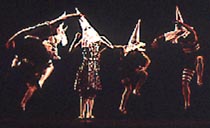
Feeble is the word for the two new works featured in the Paul Taylor Dance Company’s recent City Center season. Taylor, obviously feeling obliged to come up with a couple of novelties every year, might have created these in his sleep. Still, the sleep is the sleep of genius, so the dances display a reliably sophisticated craft and a few of the wry twists intrinsic to Taylor’s imagination. On the whole, though, these pieces look as if the animating force behind them were very, very tired.
Oh, You Kid!, set to ragtime golden oldies, is the livelier of the two new entries, but its energy is superficial, being largely a matter of the dancers’ desperate efforts to put the piece over and Santo Loquasto’s evocation of old-time bathing costumes in eye-jolting op-art patterns. The piece is a gloss on the vaudeville shows of yesteryear. A proscenium arch is outlined in electric bulbs on the backdrop; the choreographic format is a series of disparate “numbers.” Typically, Taylor inserts moments of ambiguity that reveal the “performers” as real people indentured to the tough, tawdry job of entertainment. Lisa Viola’s grotesque turn as a cooch dancer taxed beyond endurance epitomizes this theme, which, of course, invites us to consider the parallel between the life of the vaudevillian and the life of a Taylor dancer. The sardonic view and the sensitivity to the tragedy implicit in every human venture are this choreographer’s trademarks; on other occasions, they’ve been associated with more resourceful and striking dance.
In this case, Taylor resorts too often to uninflected material (generically romantic touch-dancing for the masterful Andrew Asnes and Silvia Nevjinsky, a gypsy flame), to sophomoric parody (a reincarnation of the fanatic preacher from Martha Graham’s Appalachian Spring bears witness to Taylor’s performing stint with the matriarch of modern dance), and to reiteration (once again, a love duet is echoed by subsidiary couples, as if no affair were unique). This last tactic is particularly unfortunate, diluting as it does the passages in Taylor’s oeuvre where its use is meaningful and poignant.
Fiddlers Green is as bleached out in invention as its chalky Loquasto costumes. The ten dancers are clad like hillbilly kids, the men in arch Huck Finn overalls, the women (flipping unbound tresses) in baby-doll dresses. As this little band prances with innocent joy through the opening section, you wait, breath bated, for something sinister to happen, Taylor’s two-faced worldview having trained you to expect and relish such developments. Here the calamity never occurs. All you get is a faint evocation of a country childhood that never was and never could be – a faded photo illustrating some sappy fiction.
The highlights, so to speak, of the piece are a solo for the small, compactly built Richard Chen See that capitalizes on the floating quality of his jump, and a rhythmically bouncy solo for Patrick Corbin with saucy intrusions by Takehiro Ueyama. The obligatory romantic duet (for the sensuous Rachel Berman and the miscast Thomas Patrick) sets up an awkward situation in which ostensible children indulge in clearly erotic romance. A wistful sextet fails to clarify Maureen Mansfield’s slightly set-apart role. Has this figure been made “other” because the dancer is new to the company? Because she’s meant to be seen as the young-uns’ mom? Or is she a sketch for one of Taylor’s haunting outsiders that the choreographer just hasn’t bothered to work up? Fiddlers Green is set to a John Adams score called John’s Book of Alleged Dances. The choreography remains pretty alleged, too.